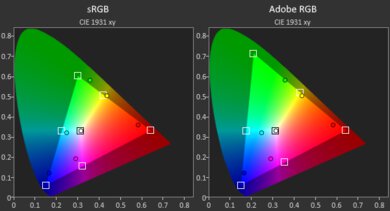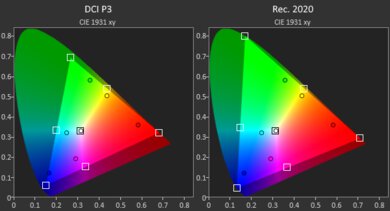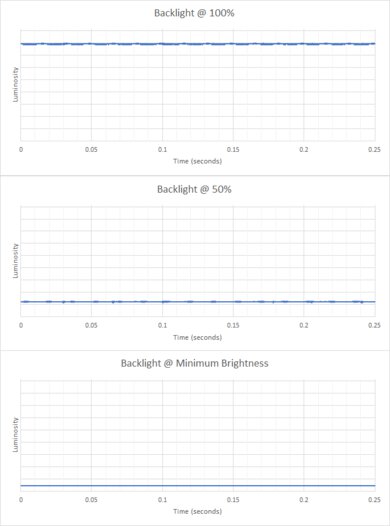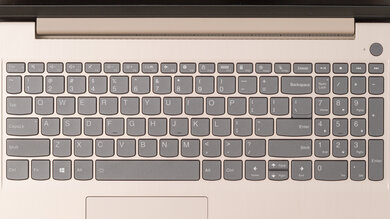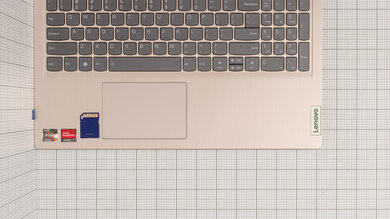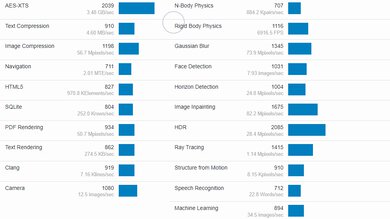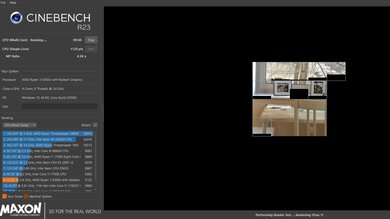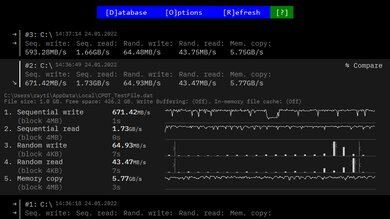The Lenovo IdeaPad 3 15 (2021) is a budget Windows ultraportable laptop. It's available with AMD Ryzen 5000 U-series CPUs, integrated graphics, up to 16GB of memory, and over 1TB of storage. You can choose between a TN or IPS display; they're both 1080p 60Hz panels with no variable refresh rate support. It has a 720p webcam, a Wi-Fi 5 wireless adapter, and a 48Wh battery. Its port selection includes two USB-As, a USB-C, an HDMI 1.4, an SD card reader, and a 3.5mm headphone jack. The USB-C port doesn't support video output or charging. You can see more details about the configurations in the Differences Between Variants section below.
Our Verdict
The Lenovo IdeaPad 3 15 is decent for school use. It feels well-built, it's easy to carry around thanks to its thin and light design, and its battery lasts easily through a typical school day. The display provides enough space for multitasking and gets bright enough for use in most settings; however, the touchpad is small, and the keyboard can be fatiguing over time. Its AMD Ryzen CPU and integrated graphics can handle most student workloads, but they aren't ideal for graphically intensive tasks like video editing.
- Easy to carry around.
- Battery lasts over nine hours of light productivity.
- Feels well-built.
- Decent webcam video quality for video calls.
- CPU can handle most light productivity tasks.
- CPU and Integrated graphics can't handle demanding workloads.
- Can't charge laptop via USB-C.
- Keyboard can cause fatigue over an extended period.
- Small touchpad makes dragging and dropping hard.
The Lenovo IdeaPad 3 15 is mediocre for gaming. Its CPU and integrated GPU aren't powerful enough to handle graphically intensive games, resulting in low frame rates and stuttery motion. It also has a slow 60Hz display with no VRR support to reduce screen tearing. On the bright side, there's very little thermal throttling over time, and it doesn't get hot under load.
- Minimal performance loss over time.
- Memory and storage are user-upgradeable.
- CPU and Integrated graphics can't handle demanding workloads.
- 60Hz refresh rate with slow response time and no VRR support.
The Lenovo IdeaPad 3 15 is decent for media consumption. It's a thin and light device that's easy to carry around, with enough battery life to get you through a couple of movies and TV show episodes. The display gets bright enough for use in most settings; however, it looks washed out, and its low contrast makes blacks appear gray in the dark. Likewise, the speakers sound clear but don't get very loud.
- Easy to carry around.
- Battery lasts nearly eight hours of video playback.
- Display supports touch input.
- Screen looks washed out.
- Low contrast ratio makes blacks look gray in dim settings.
- Can't charge laptop via USB-C.
The Lenovo IdeaPad 3 15 is okay as a workstation. Its CPU can handle light or even some moderately heavy workloads, especially the AMD Ryzen 7 5700U, but it's still very limited in graphical performance because it's only available with integrated graphics. Its port selection is decent, but the HDMI port is limited to the HDMI 1.4 standard. It doesn't get hot or throttle much under load, though the fans are a bit loud.
- Minimal performance loss over time.
- Memory and storage are user-upgradeable.
- Fast storage drive.
- CPU and Integrated graphics can't handle demanding workloads.
- HDMI port limited to 1.4 standard.
- Screen's narrow color gamut isn't ideal for color-critical work.
The Lenovo IdeaPad 3 15 is decent for business use. It's portable due to its thin and light design, and it has good battery life, lasting over 9 hours of light productivity. The webcam captures a decent image for video calls, the touchpad tracks reasonably well, and the keyboard is spacious but slightly tiring to type on over an extended period. Its AMD Ryzen processor can handle most tasks like text formatting, spreadsheets, and presentations. If you perform heavy multitasking, you can upgrade to the Ryzen 5 5500U or the Ryzen 7 5700U for better multi-thread performance. Unfortunately, you can't charge the laptop via USB-C, and the HDMI port is limited to the HDMI 1.4 standard.
- Easy to carry around.
- Battery lasts over nine hours of light productivity.
- Feels well-built.
- Decent webcam video quality for video calls.
- CPU can handle most light productivity tasks.
- CPU and Integrated graphics can't handle demanding workloads.
- Can't charge laptop via USB-C.
- Keyboard can cause fatigue over an extended period.
- Small touchpad makes dragging and dropping hard.
- HDMI port limited to 1.4 standard.
Changelog
- Updated Jul 23, 2024: Added mention of the Lenovo Yoga 6 13 (2023) as a more compact alternative in the Portability section.
- Updated Dec 07, 2023: Converted to Test Bench 0.8.2.
- Updated Nov 03, 2023: Converted to Test Bench 0.8.1.
- Updated May 16, 2023: Added mention of the ASUS Vivobook 16 M1605 (2023) as an alternative with a better touchpad in the Touchpad section.
Check Price
Differences Between Sizes And Variants
We tested the Lenovo IdeaPad 3 15 (model 82KU00YQUS) with a 1080p touch-sensitive IPS display, an AMD Ryzen 3 5300U CPU, AMD Radeon RX Vega 6 integrated graphics, 8GB of RAM, and 512GB of storage. The display, CPU, GPU, memory, storage, and color are configurable; you can see the options in the table below. There are many Lenovo IdeaPad 3 models, so to avoid confusion, our review applies only to variants with a model number starting with '82KU'.
| Screen |
|
|---|---|
| CPU |
|
| GPU |
|
| Memory |
|
| Storage |
|
| Color |
|
Our display and performance results are only valid for the configuration we tested. If you come across a different configuration option not listed above, or you have a similar Lenovo IdeaPad 3 laptop that doesn't correspond to our review, let us know, and we'll update it. Some tests, like black uniformity and color accuracy, may vary between individual units.
You can see our unit's label here.
Popular Laptop Comparisons
The Lenovo IdeaPad 3 15 is among the best laptops in its class. It stands out for its sturdy build and good battery life. However, the keyboard can be tiring to type on for an extended period, and the touchpad is small, making it hard to use.
For other options, check out our recommendations for the best laptops under $300, the best laptops under $400, and the best laptops under $500.
The Lenovo IdeaPad 5 15 (2021) and the Lenovo IdeaPad 3 15 (2021) are very similar overall, as the IdeaPad 5 is essentially a higher-tier model of the same lineup. The IdeaPad 5 provides a better user experience as its keyboard feels more comfortable to type on, and its touchpad tracks better. Also, the IdeaPad 5's USB-C port supports charging and video output, whereas the IdeaPad 3's USB-C can only transfer data. The IdeaPad 5's Intel 11th Gen processors perform better than the IdeaPad 3's AMD Ryzen 5000-series CPUs, but they aren't as power-efficient, meaning battery life is better on the IdeaPad 3, especially for video playback.
The Lenovo IdeaPad 3 15 (2021) is better than the Acer Aspire 3 15 (2023) for most uses. The Lenovo's build feels sturdier, and its battery lasts much longer. It's available with a better IPS display, as it gets brighter to combat glare, and its wider viewing angle makes it easier to share the screen with someone else. The Lenovo is an older model with AMD Ryzen 5000-series CPUs; however, depending on which configuration you get, it performs just as well or better than the Acer, which is only available with an Intel Core i3-N305 CPU.
The Lenovo IdeaPad 3 15 (2021) and the Dell Inspiron 15 3000 (2020) are both 15.6 inch Windows laptops. The IdeaPad 3 is better than the Inspiron 15 for most uses because it has a sturdier build, a brighter and more color-accurate display, and longer battery life. It also has a more comfortable keyboard, a better webcam, and a wider port selection. The IdeaPad 3 is available with AMD Ryzen 5000 CPUs, while the Inspiron 15 is available with Intel 11th Gen CPUs. The AMD and Intel processors have similar single-thread performance for the most part; however, the AMD Ryzen CPUs perform better in multi-threaded workloads due to their higher core count, especially the Ryzen 5 5500U and Ryzen 7 5700U processors.
The Lenovo IdeaPad Slim 3i 15 (2023) and the Lenovo IdeaPad 3 15 (2021) are very similar overall. The Slim 3i has a better keyboard and a more responsive touchpad, and its USB-C supports video output and charging. Also, the IdeaPad Slim 3i is available with newer and faster Intel 13th Gen. CPUs. However, the IdeaPad 3 15's screen gets slightly brighter to combat glare, and its battery lasts longer.
Test Results

The Lenovo IdeaPad 3 15 is a basic-looking laptop that shouldn't stick out in a professional environment. As it's a 15.6-inch device, it has enough room on the deck for a full-size keyboard with a Numpad on the right side. The exhaust vents are on the bottom near the back, while the speakers are near the front. It's available in four color schemes: Sand, Abyss Blue, Arctic Gray, and Galaxy Blue.
The Lenovo IdeaPad 3 15 is relatively thin and light for a 15.6-inch device, and its included power adapter is compact. Both fit easily into most bags. If you want an even more compact laptop for on-the-go use, check out the Lenovo Yoga 6 13 (2023).
The serviceability is good. To access the internals, you have to remove ten Philips screws and pry open the panel with a pick or prying tool. The model with 8GB of memory has 4GB soldered onto the motherboard and the other 4GB in the form of a user-replaceable SO-DIMM module. Lenovo's specifications indicate that you can upgrade the SO-DIMM module up to 8GB for a maximum of 12GB. The laptop comes with an M.2 2242 SSD, but the slot also supports longer M.2 2280 SSDs.
The Lenovo IdeaPad 3 is available with the following displays:
- 15.6" TN 1920 x 1080 60Hz (with or without touch input)
- 15.6" IPS 1920 x 1080 60Hz (with or without touch input)
A 1080p resolution looks decently sharp on a 15.6-inch screen. You can see the individual pixels at normal viewing distances, but it's not too bad. Its 16:9 aspect ratio is great for media consumption since most videos are in the same format, although a 16:10 or 3:2 aspect ratio would have been better for productivity, as the increased vertical space lets you see more text when reading a document or website, meaning you won't have to scroll as much. For the best viewing experience, it's best to get a model with an IPS panel because TN panels usually have worse viewing angles and color reproduction.
The display gets reasonably bright, just slightly above the advertised 300 cd/m². It's bright enough to combat glare in most settings, but not for outdoors in broad daylight. It gets very dim at the lowest brightness setting, which is great for dark room viewing, as it causes less eye strain. The TN panel is advertised to have a maximum brightness of 250 cd/m². If you need a laptop with a brighter display, check out the Acer Swift 3 14 (2022).
The Lenovo IdeaPad 3 15 has decent reflection handling. Its matte anti-reflective coating does a good job of diffusing bright lights and reducing their intensity. However, it's still possible to see some reflections even with the screen at maximum brightness.
The black uniformity is okay. The whole screen is more dark blue than black. There's some clouding here and there, as well as some backlight bleed along the top and bottom edges of the screen. The TN panel's uniformity will likely be much worse due to the TN panel's narrow viewing angles.
The Lenovo IdeaPad 3 has an okay horizontal viewing angle. The image looks noticeably darker from the sides, so you have to be close or directly in front of the screen to get the best accuracy. The TN panel will have a significantly worse viewing angle.
The Lenovo IdeaPad 3 has an okay vertical viewing angle. There's some color shift and darkening of the image when viewing from above or below. However, you still have a bit of play to tilt the screen before image accuracy degrades. The TN panel's viewing angle will be worse.
The display's overall accuracy is only decent. Most colors look inaccurate due to the panel's narrow color gamut; however, the white balance is outstanding, and the color temperature is very close to the standard 6500K target. The gamma doesn't quite follow the sRGB curve, causing dark scenes to appear darker than they should and bright scenes to be over-brightened.
The Lenovo IdeaPad 3 has a poor color gamut. It doesn't even have full coverage of the commonly-used sRGB color space, so most content looks washed out. It also has poor coverage of wider color spaces like Adobe RGB, DCI P3, and Rec. 2020. This display isn't suitable for any color-critical work or viewing HDR content. The TN panel will perform similarly.
The Lenovo IdeaPad 3 has a decent keyboard. The size and key spacing are alright, though the Numpad feels a bit more cramped. The keys have a good amount of travel and provide tactile feedback, but they require a lot of force to actuate, which might cause fatigue over an extended period. They also feel unstable and somewhat cheap. You can adjust the backlight brightness or turn it off completely using FN and the spacebar. Unfortunately, the backlight only lights up around the keys, not through the key legends. Also, backlighting is an optional feature, so some models don't have it. If you want a similar laptop with a better keyboard, check out the Lenovo IdeaPad 5 15 (2021).
The Lenovo IdeaPad 3 15 has an okay touchpad. It's a bit small and doesn't feel smooth, and you can only click near the bottom of the touchpad, making dragging and dropping over long distances hard. Palm rejection is usually okay, but there are some instances where it would register a movement or tap. If you want a laptop with a better touchpad, check out the ASUS Vivobook 16 M1605 (2023).
The Lenovo IdeaPad 3 has decent speakers. They sound clear but slightly unnatural, with almost no bass whatsoever. There's very little dynamic compression at max volume, although these speakers don't get very loud, to begin with.
The webcam's video quality is decent. It captures some fine details like the writing on the bottle or the cards, but the whole image is overexposed, making colors appear washed out. The microphone sounds good overall; however, it's a bit quiet, and there's some static in the background. The privacy cover is only a physical switch and doesn't deactivate the camera at the software level, so it can still record audio when shut. Lastly, Lenovo's specifications indicate there's a Windows Hello-compatible IR camera to log in via facial recognition, but the feature isn't available when we tried activating it in Windows.
The Lenovo IdeaPad 3 has a decent port selection. There are two USB-A ports; the one on the left supports USB 3.2 Gen 1 standard (up to 5Gbps data transfer), while the one on the right supports only USB 2.0 standard (up to 480Mbps). The USB-C port also supports USB 3.2 Gen 1 data transfer rate. Unfortunately, you can't use the USB-C to charge the laptop or connect an external display.
The Lenovo IdeaPad 3 laptop's wireless adapter is a Realtek 8822CE. Lenovo advertises Wi-Fi 6 and Bluetooth 5.1 support on some models; however, they don't specify which wireless adapter those models use.
The Lenovo IdeaPad 3 is available with the following CPUs:
- AMD Ryzen 3 5300U (4 cores/ 8 threads, up to 3.8GHz)
- AMD Ryzen 5 5500U (6 cores/12 threads, up to 4.0GHz)
- AMD Ryzen 7 5700U (8 cores/16 threads, up to 4.3GHz)
All three options are low-power CPUs designed for general productivity tasks like text processing, video playback, and web browsing. For most people with such a light workload, the Ryzen 3 5300U is likely more than powerful enough. If you have a heavier workload or need to run heavily multi-threaded applications, it's best to go with the AMD Ryzen 5 5500U or the Ryzen 7 5700U, as their increased core count and faster clock speeds will result in a smoother experience.
The Lenovo IdeaPad 3 is only available with integrated graphics. The AMD Ryzen 3 5300U CPU has Radeon RX Vega 6 graphics, the AMD Ryzen 5 5500U has Radeon RX Vega 7 graphics, and the AMD Ryzen 7 5700 has Radeon RX Vega 8 graphics. All three GPUs can only handle light tasks, not for demanding workloads like gaming or video editing. Although there's some difference in graphical performance between the three GPUs, the difference is extremely minimal.
You can configure the Lenovo IdeaPad 3 with 4, 8, 12, or 16GB of memory. It's best to get at least 8GB because 4GB is only barely enough for the operating system and may cause some slowdowns or stutters when multitasking.
The Lenovo IdeaPad 3 is available with 128GB, 256GB, 512GB, or 1TB of storage. You can also configure it with only a 5400 RPM 1TB hard drive or in combination with an SSD; however, it's best to avoid these models as the physical drive is significantly slower, and to make space for the drive, these models have a smaller 38Wh battery.
The Lenovo IdeaPad 3 scores reasonably well in the Geekbench 5 benchmarks. These scores indicate that the AMD Ryzen 3 5300U can provide a smooth experience in light workloads like text formatting, web browsing, and video playback. However, it'll struggle if you push it too hard with demanding tasks like video editing. The AMD Ryzen 5 5500U and Ryzen 7 5700U have better single-thread performance than the Ryzen 3 5300U, but it's mainly in multi-thread performance that you'll see the most gains, so they're better suited for people who perform heavy multitasking or use heavily multi-threaded applications. As for GPU computing tasks, none of the integrated graphics are powerful enough to handle such tasks. If you need to perform GPU-intensive tasks, it's best to get a laptop with a dedicated GPU.
The Lenovo IdeaPad 3 with an AMD Ryzen 3 5300U performs well in Cinebench R23's CPU rendering test. That said, if you do rendering work professionally, there are much faster CPUs on the market that are more suitable, like the Intel and AMD H-series processors and Apple's in-house ARM-based silicon. Upgrading to the AMD Ryzen 5 5500U or the Ryzen 7 5700U will give you better performance overall, but they still won't match the H-series CPUs found in mobile workstations and gaming laptops.
The Lenovo IdeaPad 3 laptop performs poorly in Blender. The CPU takes a long time to render the simple bmw27 scene, and it takes even longer with the integrated GPU. The AMD Ryzen 5 and 7 can complete this task faster, as Blender scales well with core count, but they'll likely still be too slow for professional workloads.
Like most systems with integrated graphics, the Lenovo IdeaPad 3 performs poorly in the Basemark GPU benchmark. This means it can only handle simple puzzle-like games, not graphically demanding AAA titles. The AMD Ryzen 5 5500U and the Ryzen 7 5700U will only perform slightly better, not enough to make much of a difference in most games.
The Lenovo IdeaPad 3's storage drive performance is excellent. Its fast read and write speeds mean the system can boot up, launch apps, and transfer large files quickly. Some models have a 2.5 inch physical hard drive as the primary or secondary drive. It's best to avoid models with a physical hard drive as the main drive because it's significantly slower than SSDs, and these variants have a smaller battery, which means you're trading battery life for storage. The speed of the SSD may vary depending on the size, as larger SSDs tend to perform better.
The Lenovo IdeaPad 3 15 has good battery life. You can get through a typical 8-hour day of light productivity with a bit of charge to spare. Video playback drains the battery faster; however, it still lasts long enough to get through a couple of movies and TV show episodes. Battery life is very short for gaming but much better than most gaming laptops with a dedicated GPU. The AMD Ryzen 5 5500U and Ryzen 7 5700U models will likely have shorter battery life due to their higher CPU core count and faster clock speeds. Models with a 2.5-inch hard drive or space to add one have a smaller 38Wh battery. Battery life can vary greatly depending on your usage.
Borderlands 3 runs terribly on the Lenovo IdeaPad 3 15. It's near unplayable even at the lowest graphical settings due to low frame rates and stutters. The AMD Ryzen 7 5700U can likely reach an average of 30fps with low settings, but you'll still see a lot of stutters.
Civilization VI runs poorly on the Lenovo IdeaPad 3 with an AMD Ryzen 3 5300U. It's a bit choppy at high graphical settings due to low frame rates, but it's much smoother if you turn down some settings. The turn time is okay and within the same ballpark as other AMD Ryzen 5000 and Intel 11th Gen. U-series CPUs. The AMD Ryzen 5 5500U and the AMD Ryzen 7 5700U will perform only slightly better.
The performance in CS:GO is middling. It doesn't quite reach 60fps at 1080p with high settings, and the frame rate frequently drops into the 20s, causing noticeable stutters. However, you can get much smoother gameplay if you turn the graphical settings down to minimum. The AMD Ryzen 5 5500U and the Ryzen 7 5700U will perform better, but not by much.
Shadow of the Tomb Raider runs awfully on the Lenovo IdeaPad 3 with an AMD Ryzen 3 5300U. The average frame rate doesn't even reach 30 fps at the lowest graphical settings, and there are lots of stutters. The AMD Ryzen 5 5500U and the AMD Ryzen 7 5700U models will only perform slightly better, not enough to make the game playable.
The Lenovo IdeaPad 3's keyboard deck is cool at idle and only gets slightly warm under load. However, the fans kick in pretty quickly, which explains the low temperature, and they get fairly loud. There's some space between the keyboard and the motherboard keeping the two parts separate, which also helps keep the keyboard cool.
The Lenovo IdeaPad 3's performance over time is outstanding. Neither the CPU nor GPU gets hot under load, and although there's a little bit of throttling on the CPU, the average amount of performance loss is extremely minimal and isn't noticeable. The AMD Ryzen 5 5500U or Ryzen 7 5700U will likely perform similarly.
The Lenovo IdeaPad 3 has a few pre-installed applications, including:
- McAfee LiveSafe: Antivirus/Anti-malware software.
- Dolby Audio: Lets you access the EQ settings for the built-in speakers.
- Lenovo Vantage: Helps keep the drivers and BIOS up to date.
- Lenovo Voice: Text-to-speech application.
- Lenovo Hotkeys: Lets you create keyboard macros.






















